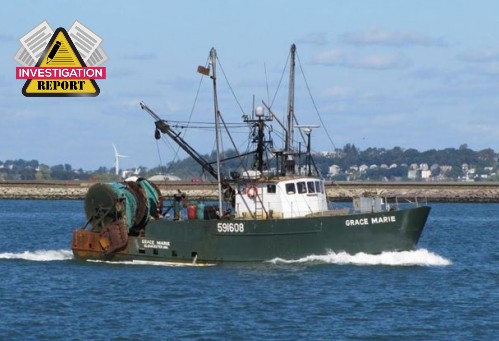The National Transportation Safety Board (NTSB) has issued an investigation report regarding the flooding and sinking of fishing vessel Grace Marie, on 8th July 2022.
On July 8, 2022, about 2200 local time, the fishing vessel Grace Marie was about 80 miles east of Gloucester, Massachusetts, transiting to fishing grounds, when the engine room began flooding.
The crew of seven was unable to pump out the water with the vessel’s bilge pumping system, and they abandoned the vessel into an inflatable liferaft. A nearby Good Samaritan vessel rescued the crew, and no injuries were reported. An oil sheen was observed the next day in the area where the vessel was last seen. The Grace Marie, valued at $650,000, was a total loss.
The Grace Marie, a steel-hulled stern trawler previously named the Paul & Dominic, was built in 1978 by Rhode Island Marine Services in Snug Harbor, Rhode Island. The current owner, AGV Company, purchased the vessel in 1997 and renamed it the Grace Marie. Homeported in Gloucester, Massachusetts, the
Grace Marie was an uninspected commercial fishing vessel used exclusively for ground fishing. It was powered by a single 565-hp Caterpillar engine.
The vessel’s main deck had a working deck aft, rigged with dual net drums set above net ramps, and a deckhouse consisting of crew quarters, a galley, and storage areas forward. The wheelhouse was located above the deckhouse.
While the captain was navigating the Grace Marie from the wheelhouse, the engine room bilge high and high-high level alarms sounded. After investigating in
the engine room, the captain and deckhand 2 noticed the seawater level rising quickly and uncontrollably in the engine room bilge. To determine the source of the flooding and slow or stop the inrush of water, the captain secured the seacocks and started all available bilge pumps.
Unable to stem the rising water level in the bilge, he ordered his crew to don immersion suits and broadcast a mayday call while he and another crewmember readied the liferaft. After they completed preparations, the captain ordered all crewmembers to abandon the vessel. The captain’s early, quick, and effective decision-making led to the successful abandonment of the vessel by all crewmembers—without having to enter the water or sustaining injuries—and their prompt rescue by the Good Samaritan vessel Dawn T.
The precise cause of the flooding aboard the Grace Marie that ultimately led to its sinking could not be determined. The vessel was not salvaged, nor was an
underwater survey of the wreck conducted. However, high and high-high bilge level alarms indicated the flooding began in the engine room, as bilge alarms in the lazarette and fish hold did not activate while the crewmembers were on board the vessel. Therefore, it is unlikely those spaces were the source of the initial flooding.
Also, it is unlikely that a problem with the vessel’s running gear, such as a shaft failure, contributed to the initial flooding because the vessel was still able to navigate with propulsion and steering during the early stages of flooding. Deckhand 1, who was transferring fuel in the forward part of the engine room shortly before the engine room bilge alarm sounded, did not notice anything out of the ordinary. Both the captain and deckhand 2, while investigating the source of water in the engine room bilge, witnessed the water level in the bilge “rising fast,” but could not pinpoint where the water was coming from.
Probable Cause
The National Transportation Safety Board determines that the probable cause of the flooding and sinking of fishing vessel Grace Marie was uncontrolled flooding of the engine room from an undetermined source, likely a failure of the doubler-plated hull below the engine room.
Lessons learned
Although doubler plating can be used as a temporary repair solution, it is not generally suitable as a permanent repair for a vessel’s hull. Vessel owners should crop out wasted steel on the hull and replace it by inserting new plating instead of covering it up with doubler plating.






























































